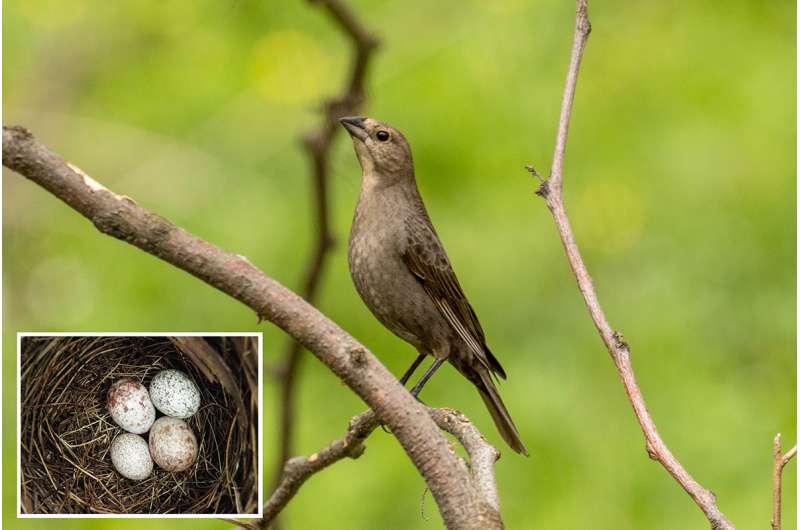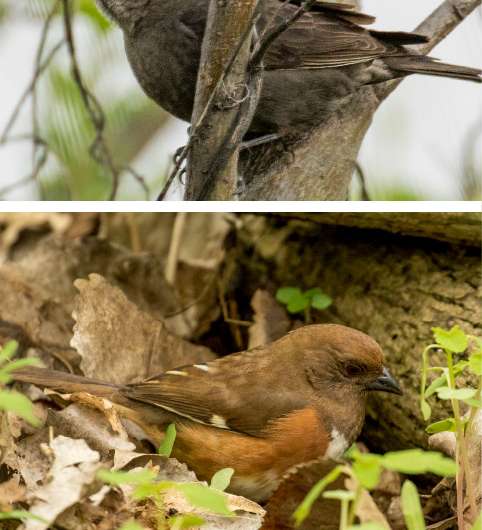Cowbird moms choosy when selecting foster parents for their young

Brown-headed cowbirds are unconventional mothers. Rather than building nests and nurturing their chicks, they lay their eggs in the nests of other species, leaving their young ones to compete for resources with the foster parents' own hatchlings. Despite their reputation as uncaring, absentee moms, cowbird mothers are capable of making sophisticated choices among potential nests in order to give their offspring a better chance of thriving, a new study shows.
Brown-headed cowbirds are known to lay their eggs in the nests of more than 200 other bird species of varying sizes, and typically do so after the host bird has laid her own eggs. The new study, led by a team at the University of Illinois, found that when cowbird mothers chose the nest of a larger host bird, they preferred those that held smaller-than-average eggs for that species. Smaller host eggs give the cowbird eggs a better chance of being successfully incubated; smaller host hatchlings mean the cowbird chicks face less competition for food and nest space.
"It implies a level of resolution in cowbird decision-making that people hadn't seen before," said Loren Merrill, a postdoctoral researcher at the Illinois Natural History Survey who conducted the study with INHS scientists Scott Chiavacci and Thomas Benson and Illinois State University researcher Ryan Paitz.
"Scientists originally saw cowbirds as egg dumpers that would put their eggs in any nest they found," Merrill said. "And while that may be the case in some areas, or for some birds, it doesn't tell the whole story. In fact, the more people have looked at cowbird behavior, the more our understanding has evolved of exactly how discriminating cowbirds can be."
The findings are reported in the journal Oecologia.
From April through August for five seasons ending in 2015, the researchers hunted through 16 shrubland sites across Illinois, looking for cowbirds and nests in which cowbirds might place their eggs.
"Nest searching is really fun fieldwork, except when you're trekking through poison ivy- and hawthorn-infested lands," Merrill said. "You either get really lucky and see nesting material in a bird's mouth, and you watch until they lead you to a nest, or you listen and watch for the vocalizations and behaviors the adults use when you are close to a nest."

Cowbirds use similar tactics to scout for host nests.
"They do a lot of skulking around the underbrush," Merrill said. "They'll also perch in an inconspicuous place and just watch. They are cuing in on the behavior of hosts that are building their nests or taking food back to nests."
The research team found nearly 3,000 nests of 34 bird species and checked each nest roughly every three days. Cowbirds placed eggs in more than 400 of these nests. In addition to weighing and measuring cowbird and host eggs in more than 180 nests, the researchers also tested the composition of some cowbird eggs to determine whether female cowbirds give some eggs an added boost, such as a greater proportion of yolk or higher levels of yolk hormones like testosterone.
"The cowbird could adjust allocation to the egg based on the perceived value of that egg. If she thinks the egg is in a good environment, she can invest more," Merrill said. "Or, if the host isn't appropriate and she doesn't think the environment is favorable, she could invest less."
The researchers found no variation in egg investment based on the differences among host species or size variations within a host species, however.
"We didn't see evidence that female cowbirds were adjusting resources in that respect, but that's not to say it isn't happening," Merrill said.
Tracking individual female cowbirds would help scientists better understand how mother cowbirds try to help their offspring.
"It's really hard to do," he said. "But being able to track the individual females over time and identify where they are depositing eggs would provide a lot of insight into how much of what we see is an adaptive allocation strategy, or whether the mother's health and other constraints are driving her behavior."
More information: Loren Merrill et al, Rates of parasitism, but not allocation of egg resources, vary among and within hosts of a generalist avian brood parasite, Oecologia (2017). DOI: 10.1007/s00442-017-3870-z
Journal information: Oecologia
Provided by University of Illinois at Urbana-Champaign



















